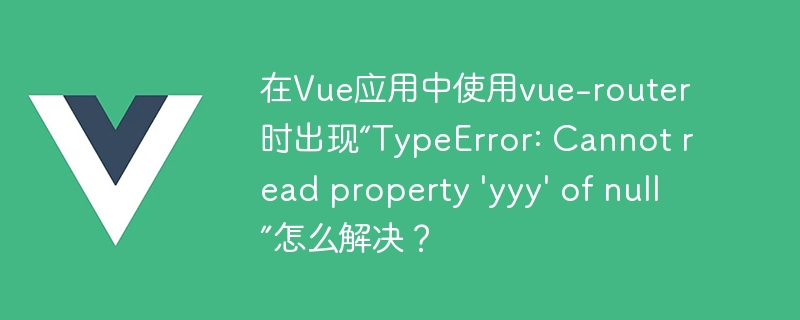

When using vue-router in a Vue application, sometimes the error message "TypeError: Cannot read property 'yyy' of null" will appear in the code. This is an error caused by the incorrect routing path of the page or incorrect passing of some routing parameters when using vue-router. This article will introduce the causes and solutions to this problem.
Cause
"TypeError: Cannot read property 'yyy' of null" appears when using vue-router. It is generally caused by the following reasons:
1. Routing path Error: When using vue-router, a non-existent or undefined page is accessed due to an incorrect routing path, or some parameters are not passed in the routing, resulting in code running errors.
2. Component internal code errors: Sometimes when writing code inside a component, errors such as referencing undefined variables or functions, or some attributes having null values may occur.
3. Component instantiation error: When the component is instantiated, the parameter type passed is incorrect or the parameter is a null value, resulting in a code running error.
Solution
For different reasons, we can adopt different solutions to solve this problem.
1. Routing path error
When an error message such as "TypeError: Cannot read property 'yyy' of null" appears, you need to check whether the routing path of the page is correct. First, you can check whether the routing configuration is correct and whether the correct corresponding components are configured for the corresponding route.
Secondly, you need to check whether the page parameters are passed correctly. When passing parameters, you need to pay attention to whether the passed parameter type is correct, whether it is null, etc. When passing parameters inside the component, you can use props to define, for example:
<template>
<div>
<h1>{{title}}</h1>
</div>
</template>
<script>
export default {
name: 'Article',
props: {
title: String,
},
};
</script>Use props to pass parameters in the routing configuration:
const routes = [
{
path: '/article/:id',
name: 'Article',
component: Article,
props: true,
}
]2. Error in the internal code of the component
When the error message "TypeError: Cannot read property 'yyy' of null" appears inside the component, you need to check whether there are errors in the internal code of the component. First you need to check whether the variable or function is correctly defined. If you are using a third-party library, you need to check whether the library file is correctly introduced.
Secondly, you need to check whether the data transfer between components is correct. In Vue, you can use event bus or Vuex for data transfer and management. The event bus can use $emit and $on of the Vue instance to deliver and listen for events, such as:
// Event Bus.js
import Vue from 'vue';
export const EventBus = new Vue();
// Component 1.js
import { EventBus } from './Event Bus.js';
export default {
name: 'Component1',
created: function() {
EventBus.$on('event-name', this.handleEvent);
},
methods: {
handleEvent: function(data) {
console.log('Received data:', data);
},
}
};
// Component 2.js
import { EventBus } from './Event Bus.js';
export default {
name: 'Component2',
created: function() {
EventBus.$emit('event-name', 'Hello World');
},
};or use Vuex for data management, such as:
// store.js
import Vue from 'vue';
import Vuex from 'vuex';
Vue.use(Vuex);
const store = new Vuex.Store({
state: {
message: 'Hello World',
},
mutations: {
setMessage: (state, payload) => {
state.message = payload;
},
},
actions: {
updateMessage: ({commit}, payload) => {
commit('setMessage', payload);
},
}
});
export default store;
// Component 1.js
import { mapState } from 'vuex';
export default {
name: 'Component1',
computed: {
...mapState(['message']),
},
};
// Component 2.js
import { mapActions } from 'vuex';
export default {
name: 'Component2',
methods: {
...mapActions(['updateMessage']),
handleClick: function() {
this.updateMessage('Updated Message');
},
},
};3. Component instantiation error
When the component is instantiated and the error message "TypeError: Cannot read property 'yyy' of null" appears, you need to check whether the passed parameter type is correct or whether the parameter is empty. In Vue, you need to pay attention to whether the type of the property is correct when defining props.
In addition, when instantiating a component, you can use the v-if instruction to determine whether the component needs to be instantiated. For example:
<template>
<div>
<component-a v-if="isComponentAActive"></component-a>
<component-b v-else></component-b>
</div>
</template>
<script>
import ComponentA from './ComponentA.vue';
import ComponentB from './ComponentB.vue';
export default {
name: 'App',
components: {
ComponentA,
ComponentB,
},
data: function() {
return {
isComponentAActive: true,
};
},
};
</script>When isComponentAActive is true, component ComponentA will be instantiated, otherwise component ComponentB will be instantiated.
Conclusion
When using vue-router, the error message "TypeError: Cannot read property 'yyy' of null" appears, usually due to routing path errors, component internal code errors, or Caused by problems such as component instantiation errors. When dealing with such errors, you can take appropriate solutions based on the different causes of the problem. If you still have questions, you can refer to the documentation on the Vue official website or seek help from the Vue community.
The above is the detailed content of How to solve the problem 'TypeError: Cannot read property 'yyy' of null' when using vue-router in Vue application?. For more information, please follow other related articles on the PHP Chinese website!




